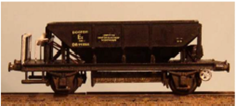Alan Gibson Wheels and Bearings
EM Gauge (18.2mm)
OO Gauge (16.5mm)
P4/S4 Gauge (18.83mm)
Cooper-Craft
Cooper-Craft 4mm Lineside
Cooper-Craft 16mm Wagons
Cooper-Craft 16mm Lineside
2mm
2mm Peco
2mm Ratio
3mm Wagon Kits
4mm Cambrian Wagon Kits
4mm Transfers
4mm Transfers BR
4mm Transfers Pre-Grouping
4mm Transfers SR
4mm Transfers LMS
4mm Transfers LNER
Private Owner
SR Pre Grouping (LBSC, LSWR, SECR)
SR
LNER
LMS & MR
GWR & Cambrian
BR Salmons and Borail
BR Steel Carriers
BR Engineering
BR Open Wagons
4mm Accessories
4mm Peco
Wagon Bogies
Etched Tie Bars
Misc. Accessories
Underframe Kits
4mm Lineside
4mm Ratio
4mm PECO-Parkside
4mm Scale OO Gauge Parkside Wagon Kits
16mmNG
Axleguards
Bogies
Brakegear
Lineside
Loco and Rolling Stock Parts
Signal Parts
Transfers
Wheels
Cooper-Craft Wagon Kits
PECO SM-32 Track
Metal Materials
Brass Micro Section
Brass Flat Section
Brass I Section
Brass L Section
Brass T Section
Brass U Section
Brass Z Section
Brass Half Round Section
Brass Half-Round Tube Section
Brass Square Profile
Metal Bar or Rod
Brass Square Bar
Brass Round Bar or Rod
Metal Strip
Brass Strip 0.2mm thick
Brass Strip 0.5mm thick
Nickel Silver Strip 0.3mm thick
Phosphor Bronze Strip 0.15mm thick
Phosphor Bronze Strip 0.3mm thick
Metal Wire
Brass Wire
Phosphor Bronze Wire
Nickel Silver Wire
Soft Iron Wire
Metal Tube
Metal Sheet
Nickel Silver Sheet
Special Orders

